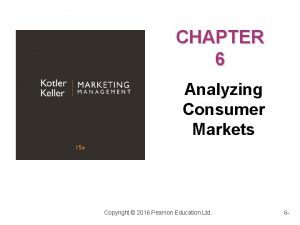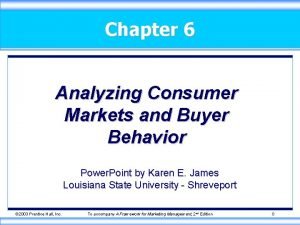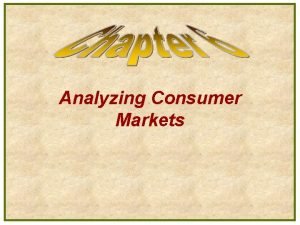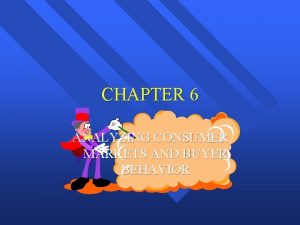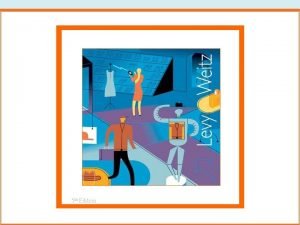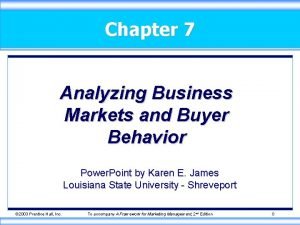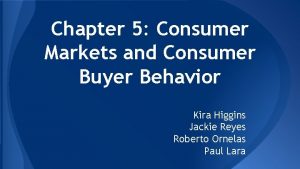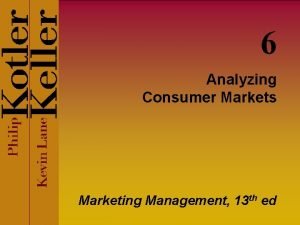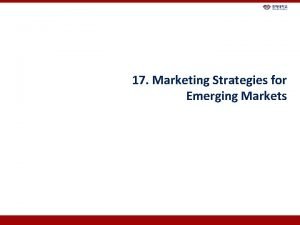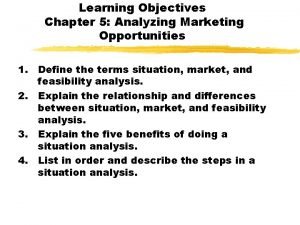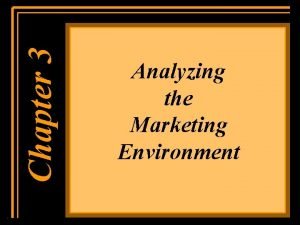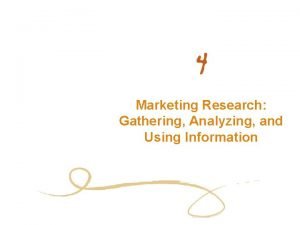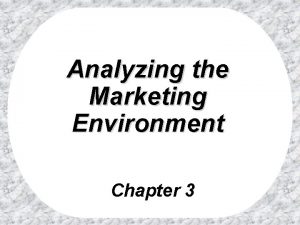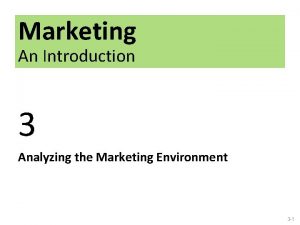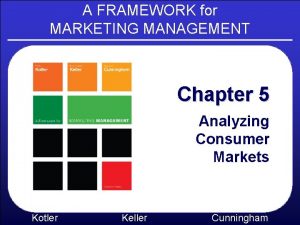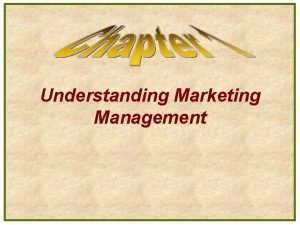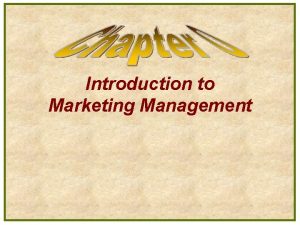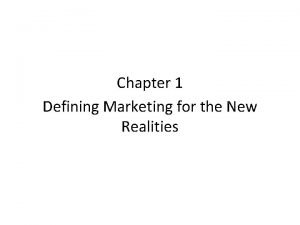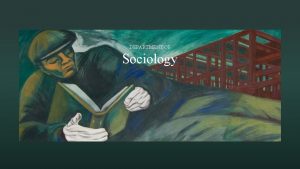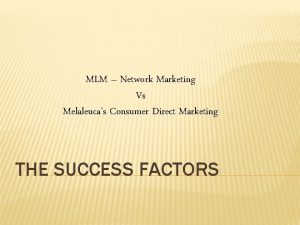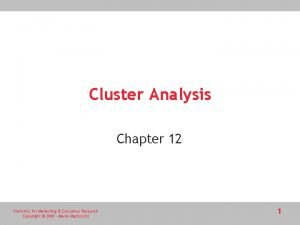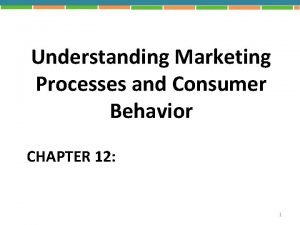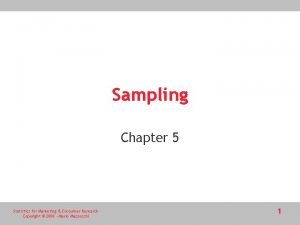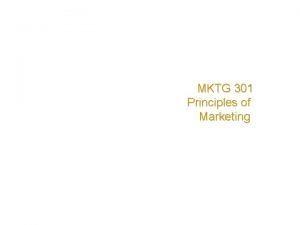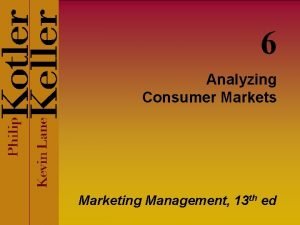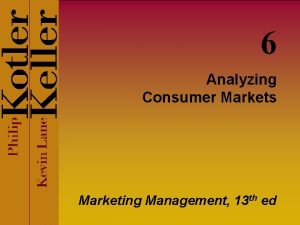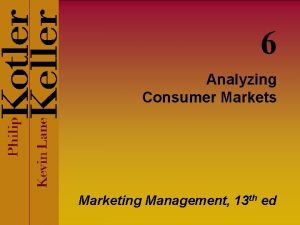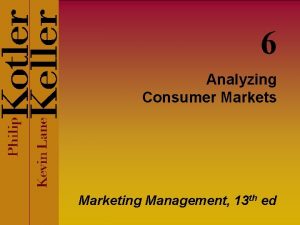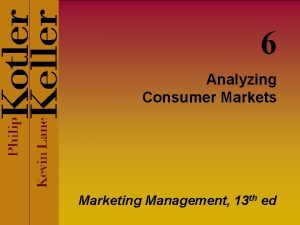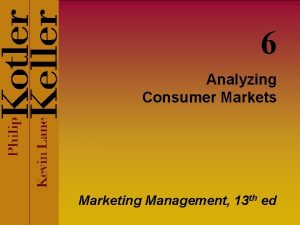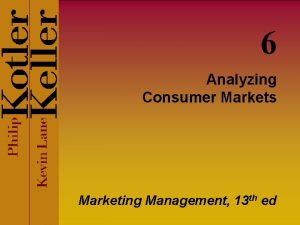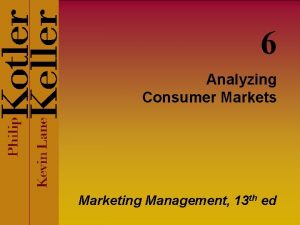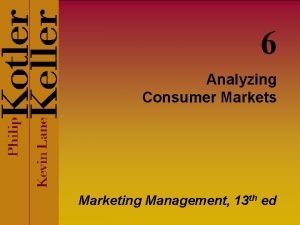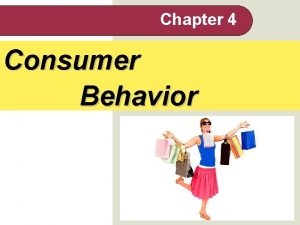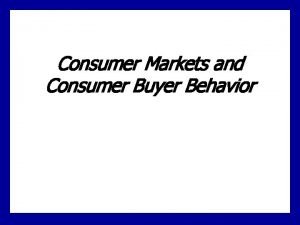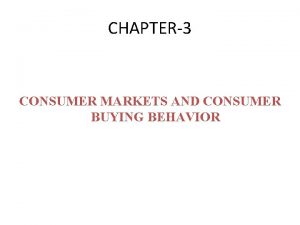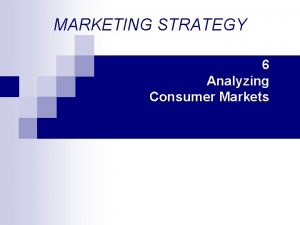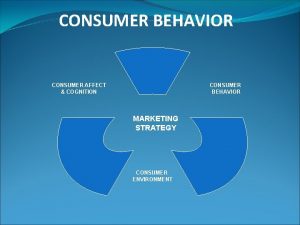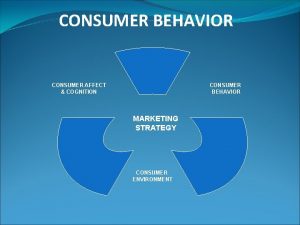6 Analyzing Consumer Markets Marketing Management 13 th




































- Slides: 36

6 Analyzing Consumer Markets Marketing Management, 13 th ed

Chapter Questions • How do consumer characteristics influence buying behavior? • What major psychological processes influence consumer responses to the marketing program? • How do consumers make purchasing decisions? • How do marketers analyze consumer decision making? Copyright © 2009 Pearson Education, Inc. Publishing as Prentice Hall 6 -2

Figure 6. 1 Model of Consumer Behavior Copyright © 2009 Pearson Education, Inc. Publishing as Prentice Hall 6 -3

What Influences Consumer Behavior? • Cultural factors • Social factors • Personal factors Copyright © 2009 Pearson Education, Inc. Publishing as Prentice Hall 6 -4

What is Culture? Culture is the fundamental determinant of a person’s wants and behaviors acquired through socialization processes with family and other key institutions. Copyright © 2009 Pearson Education, Inc. Publishing as Prentice Hall 6 -5

Subcultures • • Nationalities Religions Racial groups Geographic regions Copyright © 2009 Pearson Education, Inc. Publishing as Prentice Hall 6 -6

Fast Facts About American Culture • The average American: • • chews 300 sticks of gum a year goes to the movies 9 times a year takes 4 trips per year attends a sporting event 7 times each year Copyright © 2009 Pearson Education, Inc. Publishing as Prentice Hall 6 -7

Social Classes • • Upper uppers Lower uppers Upper middles Middle Working Upper lowers Lower lowers Copyright © 2009 Pearson Education, Inc. Publishing as Prentice Hall 6 -8

Characteristics of Social Classes • Within a class, people tend to behave alike • Social class conveys perceptions of inferior or superior position • Class may be indicated by a cluster of variables (occupation, income, wealth) • Class designation is mobile over time Copyright © 2009 Pearson Education, Inc. Publishing as Prentice Hall 6 -9

Social Factors • • Reference groups: Family Social roles Statuses Copyright © 2009 Pearson Education, Inc. Publishing as Prentice Hall 6 -10

Reference Groups • Membership groups: 1. Primary groups: Family 2. Secondary groups: Friends • Aspirational groups: those hope to join • Disassociative groups: those whose value reject Copyright © 2009 Pearson Education, Inc. Publishing as Prentice Hall 6 -11

Family Distinctions Affecting Buying Decisions • Family of Orientation: Parents which we acquire s the orientation towards religion, politics, economic and ambition • Family of Procreation; Husband , wife and children, the Purchasing role of husband wife Copyright © 2009 Pearson Education, Inc. Publishing as Prentice Hall 6 -12

Personal Factors • • Age Life cycle stage Occupation Wealth • • Personality Values Lifestyle Self-concept Copyright © 2009 Pearson Education, Inc. Publishing as Prentice Hall 6 -13

Brand Personality; Human traits that we can attribute to particular brand • • • Sincerity: honest , cheerful Excitement; imaginative Competence; reliable Sophistication; upper class and charming Ruggedness; outdoorsy, Levi’s Actual self-conception; how we view our self • Ideal self-conception; how we would like to view our self • Other self-conception; how we think other see us. Copyright © 2009 Pearson Education, Inc. Publishing as Prentice Hall 6 -14

Key Psychological Processes • Motivation: is the driving force within individuals that impels them to action. • Perception: The process by which an individual selects, organizes, and interprets stimuli into a meaningful and coherent picture of the world • Learning: The process by which individuals acquire the purchase and consumption knowledge and experience that they apply to future related behavior • Memory : (LTM& STM) Copyright © 2009 Pearson Education, Inc. Publishing as Prentice Hall 6 -15

Motivation Herzberg’s Two-Factor Freud’s Theory Behavior is guided by Behavior motivating is guided by is driven by and hygiene unconscious & lowest, Factors; subconscious unmet need motivations Most important Extrinsic: Salary Intrinsic; Growing need Maslow’s Hierarchy of Needs Copyright © 2009 Pearson Education, Inc. Publishing as Prentice Hall 6 -16

Maslow’s Hierarchy of Needs Copyright © 2009 Pearson Education, Inc. Publishing as Prentice Hall 6 -17

Perception • Selective attention: Heightened awareness when stimuli meet their needs • Selective retention: Remember positive point ignore negative one • Selective distortion: interpret the information to fit our preconception • Subliminal perception: Stimuli that are too weak or too brief to be consciously seen or heard may be strong enough to be perceived by one or more receptor cells. Copyright © 2009 Pearson Education, Inc. Publishing as Prentice Hall 6 -18

Figure 6. 4 Consumer Buying Process • • • Problem recognition Information search Evaluation Purchase decision Postpurchase behavior Copyright © 2009 Pearson Education, Inc. Publishing as Prentice Hall 6 -19

Sources of Information • • Personal Commercial Public Experiential Copyright © 2009 Pearson Education, Inc. Publishing as Prentice Hall 6 -20

Non-Compensatory Models of Choice • Conjunctive: Choose the alternative which meets the minimum of all attributes • Lexicographic: A noncompensatory decision rule - consumers first rank product attributes in terms of importance, then compare brands in terms of the attribute considered most important • Elimination-by-aspects: eliminate any brand that don’t meets minimum acceptable cutoffs for each atributes Copyright © 2009 Pearson Education, Inc. Publishing as Prentice Hall 6 -21

Perceived Risk • • • Functional: Poor product Perform Physical: Health risk Financial: is not worth the price paid Social: Embracement from other Psychological: Affect the mental well- being • Time: The failure product and the time cost needed to find another Copyright © 2009 Pearson Education, Inc. Publishing as Prentice Hall 6 -22

7 Analyzing Business Marketing Management, 13 th ed

Chapter Questions • What is the business market, and how does it differ from the consumer market? • What buying situations do organizational buyers face? • Who participates in the business-tobusiness buying process? Copyright © 2009 Pearson Education, Inc. Publishing as Prentice Hall 7 -24

Chapter Questions • How do business buyers make their decisions? • How can companies build strong relationships with business customers? • How do institutional buyers and government agencies do their buying? Copyright © 2009 Pearson Education, Inc. Publishing as Prentice Hall 7 -25

What is Organizational Buying? Organizational buying refers to the decision-making process by which formal organizations establish the need for purchased products and services, and identify, evaluate, and choose among alternative brands and suppliers. Copyright © 2009 Pearson Education, Inc. Publishing as Prentice Hall 7 -26

Characteristics of Business Markets • Fewer, larger buyers • • Close supplier • customer • relationships • • Professional • purchasing • Many buying • influences Multiple sales calls Derived demand Inelastic demand Fluctuating demand Geographically concentrated buyers Direct purchasing Copyright © 2009 Pearson Education, Inc. Publishing as Prentice Hall 7 -27

Buying Situation • Straight rebuy • Modified rebuy • New task Copyright © 2009 Pearson Education, Inc. Publishing as Prentice Hall 7 -28

The Buying Center • • Initiators Users Influencers Deciders • Approvers • Buyers • Gatekeepers Copyright © 2009 Pearson Education, Inc. Publishing as Prentice Hall 7 -29

Of Concern to Business Marketers • Who are the major decision participants? • What decisions do they influence? • What is their level of influence? • What evaluation criteria do they use? Copyright © 2009 Pearson Education, Inc. Publishing as Prentice Hall 7 -30

Stages in the Buying Process: Buyphases • • Problem recognition General need description Product specification Supplier search Proposal solicitation Supplier selection Order-routine specification Performance review Copyright © 2009 Pearson Education, Inc. Publishing as Prentice Hall 7 -31

Forms of Electronic Marketplaces • Catalog sites: e-procurement • Vertical markets: Specialized web site • Pure play auction sites: online marketplace e-buy. • Spot markets: • Private exchanges • Barter markets • Buying alliances Copyright © 2009 Pearson Education, Inc. Publishing as Prentice Hall 7 -32

Order Routine Specification • Stockless purchase plans: Blanket contracts not periodical • Vendor-managed inventory: sourcing to another company supplier • Continuous replenishment Copyright © 2009 Pearson Education, Inc. Publishing as Prentice Hall 7 -33

Establishing Corporate Trust and Credibility • Expertise: the ability of company to produce and sell products • Trustworthiness: Honesty dependable • Likability: Likable attractive Copyright © 2009 Pearson Education, Inc. Publishing as Prentice Hall 7 -34

Trust Dimensions • Transparent: Honest information • Product/Service Quality: good or bad • Incentive: Fairness • Partnering with customers: help to customers to learn • Cooperating design: customers help in design products • Product comparison: No biased in comparing • Supply chain: No conflict • Pervasive advocacy: All function work together Copyright © 2009 Pearson Education, Inc. Publishing as Prentice Hall 7 -35

What is Opportunism? Opportunism is some form of cheating or undersupply relative to an implicit or explicit contract. Copyright © 2009 Pearson Education, Inc. Publishing as Prentice Hall 7 -36
 Chapter 6 consumer behavior
Chapter 6 consumer behavior Analyzing consumer markets and buyer behavior
Analyzing consumer markets and buyer behavior Changes in an individual's behavior arising from experience
Changes in an individual's behavior arising from experience Analyzing consumer markets
Analyzing consumer markets Analyzing consumer markets and buyer behavior
Analyzing consumer markets and buyer behavior Analyzing consumer market
Analyzing consumer market Analyzing consumer markets
Analyzing consumer markets Black box model consumer behaviour
Black box model consumer behaviour Analyzing consumer markets chapter 6
Analyzing consumer markets chapter 6 Retail marketing mix ppt
Retail marketing mix ppt Analyzing consumer and business markets
Analyzing consumer and business markets Analyzing consumer markets
Analyzing consumer markets Chapter 5 consumer markets and buyer behavior
Chapter 5 consumer markets and buyer behavior Interpret a food chain or food web
Interpret a food chain or food web Chapter 5 consumer markets and buyer behavior
Chapter 5 consumer markets and buyer behavior Analyzing consumer market
Analyzing consumer market Decomposer in the sahara desert
Decomposer in the sahara desert Cengage
Cengage Consumer research in consumer behaviour
Consumer research in consumer behaviour Marketing strategies for emerging markets
Marketing strategies for emerging markets Analyzing marketing opportunities
Analyzing marketing opportunities The most dramatic force shaping our destiny is:
The most dramatic force shaping our destiny is: Analyzing and using marketing information
Analyzing and using marketing information Using marketing information to gain customer insights
Using marketing information to gain customer insights Analyzing the marketing environment
Analyzing the marketing environment Analyzing the marketing environment
Analyzing the marketing environment Chapter 5 analyzing the marketing environment
Chapter 5 analyzing the marketing environment Understanding marketing management
Understanding marketing management Definition of marketing management
Definition of marketing management Define marketing management
Define marketing management Marketing for the new realities
Marketing for the new realities Dartmouth sociology
Dartmouth sociology Consumer direct marketing companies
Consumer direct marketing companies Marketing consumer
Marketing consumer Marketing processes and consumer behavior
Marketing processes and consumer behavior Statistics for marketing and consumer research
Statistics for marketing and consumer research Marketing discovers consumer needs by
Marketing discovers consumer needs by
